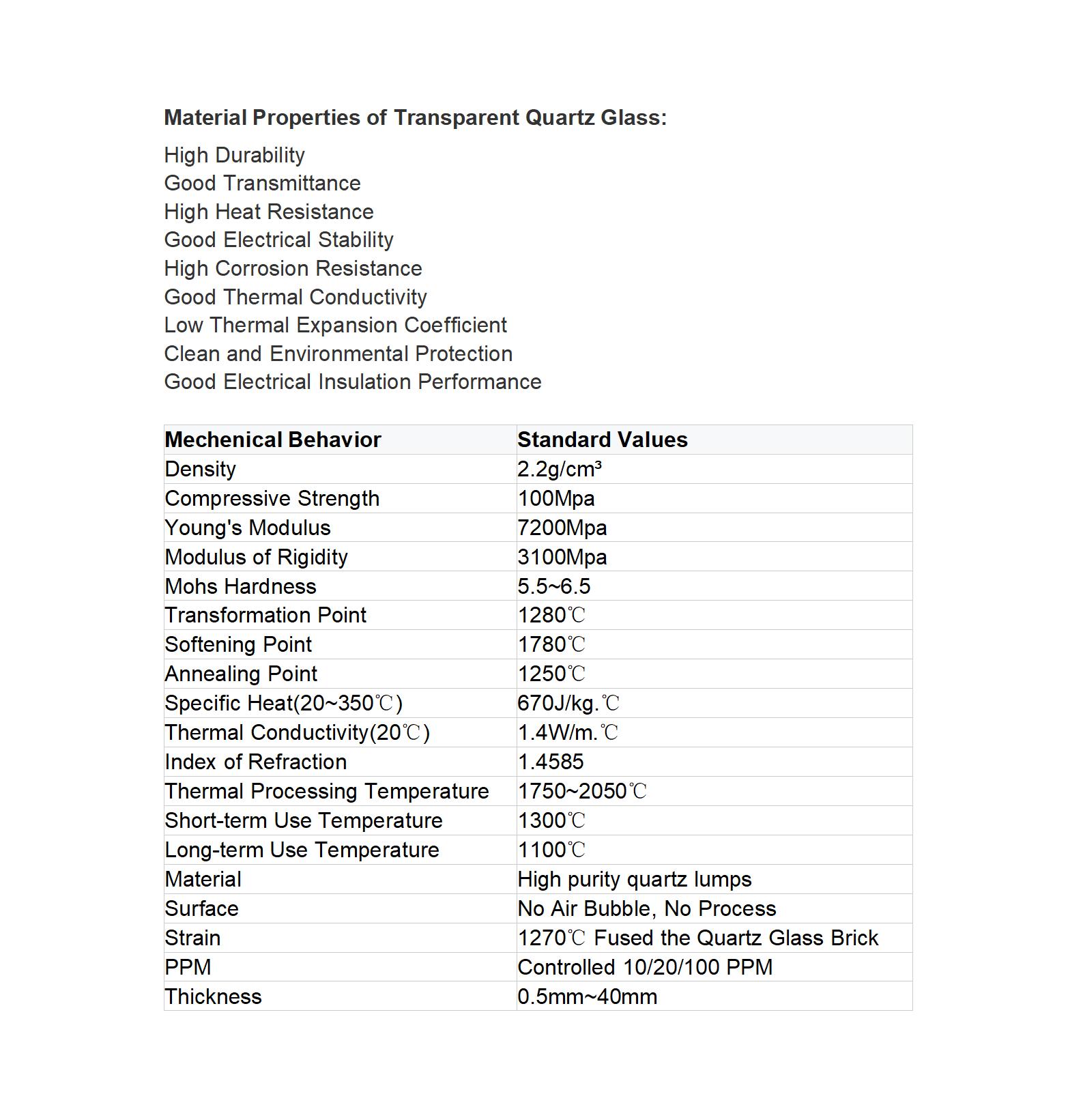T: +86-518-85528012
E: nick@luverrequartz.com
E: nick@luverrequartz.com
1st floor Runlian industrial center No. 116 QuFeng Rd., Haizhou Economic and technological development zone Lianyungang City, Jiangsu Province, China 222062
High transmittance solar light fixture quartz glass sheet
Quartz glass sheet for high transmittance solar lighting fixtures is a special type of glass specifically designed for solar photovoltaic cells.
LUVERRE quartz
99.99%
Inner with Vacuum PVC bag and then wrapped with air bubble film, outer with wooden box.
as per customer's requirement
| Availability: | |
|---|---|
High transmittance solar light fixture quartz glass sheet
Quartz glass sheet for high transmittance solar lighting fixtures is a special type of glass specifically designed for solar photovoltaic cells. This type of glass plays an important role in photovoltaic modules, directly affecting the power generation efficiency and service life of the modules. The main raw materials for photovoltaic glass include quartz sand, soda ash, etc., but compared with ordinary glass, the quality and iron content requirements for quartz sand are more stringent. The production process requirements for photovoltaic glass are high, and the initial investment is also significant.

Ultra white glass is one of the important components of solar photovoltaic cells, which requires very high transparency and therefore requires a lower iron content. In the mix of ultra white glass, quartz sand usually accounts for more than 60% by weight and is the main factor affecting the content of glass iron. The quality requirements for quartz sand in photovoltaic glass are mainly reflected in four aspects: iron content, titanium content, particle size, and refractory heavy minerals.
The quartz sand in photovoltaic glass requires an iron content of no more than 100ppm (parts per million). The presence of titanium oxides can cause discoloration of the glass, reduce light transmittance and transparency. Therefore, the titanium content of quartz sand is required to not exceed 300ppm. The particle size and grading of quartz sand can also affect the quality of photovoltaic glass. The required particle size is 0.71-0.104mm, and the proportion of particles below 0.104mm should not exceed 5%.

The high transmittance of photovoltaic glass can effectively improve the photoelectric conversion efficiency of solar cells. The requirement for light transmittance requires special attention to the selection of raw materials and processing techniques in the production process of photovoltaic glass to ensure the quality and performance of the final product.

Quartz glass sheets, with their high transmittance, excellent photoelectric performance, and strict quality control, play a key role in the solar photovoltaic industry, helping to improve the power generation efficiency and service life of solar cells.
Why choose us?
1.We are more experienced.
We have over 18 years production experience of quartz items.
2.We are more efficient.
We reply customers’ requests within 24 hours and we have high efficient production, engineers and sales team.
3.Our quality is more guaranteed.
We control the quality from quartz lumps to quartz sand and then quartz products, we have better and stricter quality control than other manufactures.
4.We are able to produce more difficult quartz products.
We have large grinding platforms and precision etching machines which enable us to produce large sizes of quartz plates, tubes and high size precision quartz items.
High transmittance solar light fixture quartz glass sheet
Quartz glass sheet for high transmittance solar lighting fixtures is a special type of glass specifically designed for solar photovoltaic cells. This type of glass plays an important role in photovoltaic modules, directly affecting the power generation efficiency and service life of the modules. The main raw materials for photovoltaic glass include quartz sand, soda ash, etc., but compared with ordinary glass, the quality and iron content requirements for quartz sand are more stringent. The production process requirements for photovoltaic glass are high, and the initial investment is also significant.

Ultra white glass is one of the important components of solar photovoltaic cells, which requires very high transparency and therefore requires a lower iron content. In the mix of ultra white glass, quartz sand usually accounts for more than 60% by weight and is the main factor affecting the content of glass iron. The quality requirements for quartz sand in photovoltaic glass are mainly reflected in four aspects: iron content, titanium content, particle size, and refractory heavy minerals.
The quartz sand in photovoltaic glass requires an iron content of no more than 100ppm (parts per million). The presence of titanium oxides can cause discoloration of the glass, reduce light transmittance and transparency. Therefore, the titanium content of quartz sand is required to not exceed 300ppm. The particle size and grading of quartz sand can also affect the quality of photovoltaic glass. The required particle size is 0.71-0.104mm, and the proportion of particles below 0.104mm should not exceed 5%.

The high transmittance of photovoltaic glass can effectively improve the photoelectric conversion efficiency of solar cells. The requirement for light transmittance requires special attention to the selection of raw materials and processing techniques in the production process of photovoltaic glass to ensure the quality and performance of the final product.

Quartz glass sheets, with their high transmittance, excellent photoelectric performance, and strict quality control, play a key role in the solar photovoltaic industry, helping to improve the power generation efficiency and service life of solar cells.
Why choose us?
1.We are more experienced.
We have over 18 years production experience of quartz items.
2.We are more efficient.
We reply customers’ requests within 24 hours and we have high efficient production, engineers and sales team.
3.Our quality is more guaranteed.
We control the quality from quartz lumps to quartz sand and then quartz products, we have better and stricter quality control than other manufactures.
4.We are able to produce more difficult quartz products.
We have large grinding platforms and precision etching machines which enable us to produce large sizes of quartz plates, tubes and high size precision quartz items.